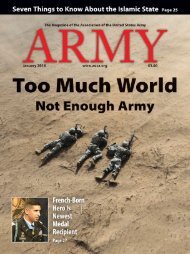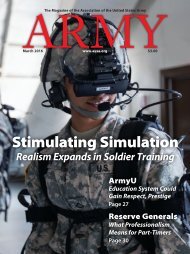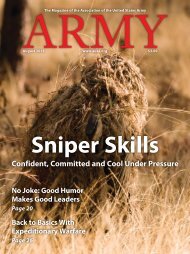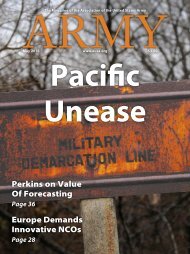All About - History - Nero - Rome's Deadliest tyrant
All About History offers a energizing and entertaining alternative to the academic style of existing titles. The key focus of All About History is to tell the wonderful, fascinating and engrossing stories that make up the world’s history.
All About History offers a energizing and entertaining alternative to the academic style of existing titles. The key focus of All About History is to tell the wonderful, fascinating and engrossing stories that make up the world’s history.
Create successful ePaper yourself
Turn your PDF publications into a flip-book with our unique Google optimized e-Paper software.
Artists in Arms<br />
Art &<br />
photography<br />
Neverbeforehadtherebeensuchastrongsensethatartcould<br />
and should be used as a political weapon<br />
The Weeping Woman is based on<br />
a central figure in Guernica and a<br />
recurring theme in Picasso’s work<br />
Astrikingfeatureoftheartstimulatedbythe<br />
eventsoftheSpanishCivilWarisitsvariety.<br />
Inallmedia,stretchingfrompaintings<br />
through posters to photography, and in a<br />
multitude of styles, artists sought to take<br />
sides. This was especially true in the Republican<br />
zone,wherethewarwasaccompaniedbyagreat<br />
flurryofartisticactivity.<br />
Spanishbybirth,theartistPabloPicassowas<br />
living in France at the time that the generals<br />
attemptedtheircoup.Hispoliticalsympathieswere<br />
with the Republic. When the Spanish Pavilion was<br />
designed for the International Exhibition in Paris<br />
in1937,Picassowascommissionedtopreparean<br />
artwork for it.<br />
Theresultisprobablythemostfamousartwork<br />
to emerge from the Spanish Civil War, namely his<br />
painting Guernica. Thesubjectofthepaintingis<br />
thebrutalbombingoftheancientBasquecapital<br />
of Guernica on 26 April 1937. Responsible for<br />
the destruction of the town and the deaths of<br />
unknown numbers of innocent civilians were the<br />
bombers of Hitler’s Condor Legion.<br />
Picassochosenottousearealiststyleto<br />
represent the horror of what had happened in<br />
Guernica.Rather,inthismassivepainting,Picasso<br />
employed an abstract style, employing traditional<br />
Spanishmotifssuchasthebullandthehorse,to<br />
convey to viewers his indignation at what many<br />
sawasanactoffascistbarbarism.<br />
Not surprisingly, the painting attracted a good<br />
dealofcontroversy,bothinParisatfirstandthen<br />
when it was displayed at<br />
othervenuesaroundthe<br />
world. That alone was<br />
asignofthepainting’s<br />
success in bringing<br />
global attention to the<br />
horrorsofthewarin<br />
Spain. An apocryphal<br />
anecdote has it that<br />
aGermanofficerin<br />
wartime Paris, seeing a<br />
photo of Guernica on the<br />
wall,askedPicassoifhedidthat,towhichtheartist<br />
responded, “No, you did.”<br />
Eventually, after the death of Franco and the<br />
restorationofdemocracyinSpain,thepainting<br />
wasplacedondisplayinMadrid,muchtothe<br />
angerofthosewhoresenteditscapacitytoturn<br />
artintoapoliticalweapon.Atfirstitwasprotected<br />
by bomb and bullet-proof glass as it drew millions<br />
of admirers from across the globe. Nowadays<br />
manyviewersregardthepaintingasnotjusta<br />
“It was natural<br />
thatamodernand<br />
progressive political<br />
causeshouldbe<br />
supportedbyart”<br />
condemnationofthebombingofGuernicabutof<br />
aggressive war generally.<br />
Picasso’s fellow-Spaniard Joan Miró also<br />
exhibited work in the Spanish pavilion in Paris.<br />
Closely associated with the surrealist movement,<br />
Miró elected to use an<br />
abstract style to express<br />
his pro-Republican<br />
political views. For him,<br />
it was natural that a<br />
modern and progressive<br />
political cause should<br />
be supported by art<br />
forms that were similarly<br />
modern and progressive.<br />
He and countless artists<br />
like him were convinced<br />
thatinadesperatewarfortheverysurvivalofthe<br />
Republic, art should attract the attention not just of<br />
aculturedelitebutawiderpopulation.<br />
Like Guernica, Miró’s work for the Paris<br />
exhibitionwasaverylargemural.TitledThe<br />
Reaper, it depicted a Catalan peasant carrying a<br />
sickleinonehandandmakingaclenchedfistwith<br />
theother.BorninBarcelona,Miró’sardentsupport<br />
oftheRepublicwasunderlinedbyhisdesirefor<br />
Catalan autonomy. On a much smaller scale, while<br />
THE REBELLION BEGINS<br />
56<br />
17 JULY 1936<br />
UPRISING IN<br />
MOROCCO<br />
The coup, which has been planned<br />
by a group of generals, is launched<br />
in Spanish Morocco, and it will soon<br />
be followed by military risings in<br />
Spain itself.<br />
19-20 JULY 1936 30 JULY 1936 14 AUGUST 1936 29 SEPTEMBER 1936<br />
SPAIN DIVIDED<br />
The coup is successful in parts of<br />
southern and northern Spain, but<br />
military and popular forces that are<br />
loyal to the government manage<br />
to defeat the coup in the cities of<br />
Madrid and Barcelona.<br />
HITLER TO<br />
THE RESCUE<br />
With the increasing possibility that<br />
the coup will fail, transport aircraft<br />
provided by Hitler ferry Franco’s<br />
Army of Africa from Spanish<br />
Morocco to Spain.<br />
MASSACRE IN<br />
BADAJOZ<br />
Insurgent forces capture the<br />
town of Badajoz in south-western<br />
Spain and stage a brutal massacre<br />
of inhabitants believed to be<br />
opponents of the uprising.<br />
FRANCO EMERGES<br />
One of the generals commanding<br />
the rebel forces, Francisco Franco,<br />
who led the Spanish Army of Africa,<br />
is declared commander in chief and<br />
head of government in the rebelheld<br />
territory.


















